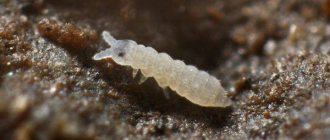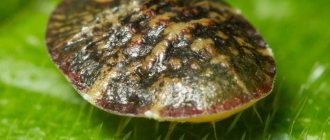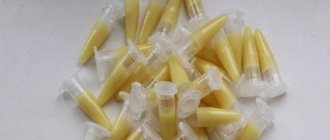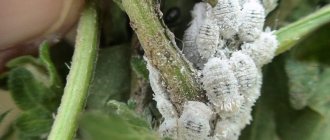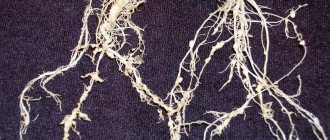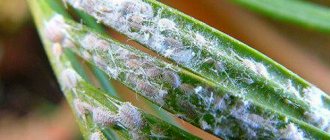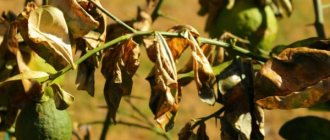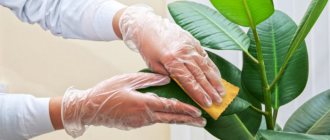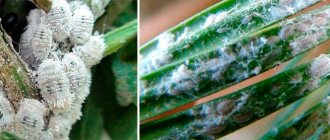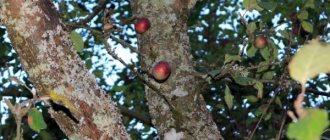Comma-shaped scale
It is found in any region and affects apple, plum, pear and even currant bushes.
Does not ignore rowan and hawthorn. On the bark of affected trees, small scutes can be seen, shaped like commas. The female is located in the narrow part of such a shield. The larvae are yellow in color and have red eyes. They leave their scutes and spread throughout the plant within a couple of weeks.
By sucking juices, the scale insect harms the plant. It can develop to such an extent that it covers branches and trunks with a continuous carpet. Over time, the affected areas of the bark die, the foliage falls off, and the young shoots dry out. The tree loses its resistance to winter and does not resist bark beetles and black cancer.
False California parasite
Harmful not only to fruit trees. It is capable of infecting hawthorn, willow, poplar, linden and yellow acacia. The shape of the insect is round or oval, the scutes are of two shades.
The larvae overwinter on tree bark. As summer approaches, the emerging females lay eggs. The emerging larvae crawl throughout the tree and stick to the bark.
Willow scale
It is more often found in northern places. It lives on currant, raspberry or gooseberry bushes, but is quite populated on aspen, rowan, bird cherry and other trees. The shields are flat in shape and resemble lime splashes in appearance.
The laid eggs overwinter under the scutes of dead females. The larvae become mobile during the currant flowering season and quickly spread throughout the plant. If the number of insects is high, then they are able to cover the branches with a continuous cover of a gray shade.
Acacia or common false shield
Found on grapes and other stone fruits. The shape is a semicircular shield of a reddish color. Females attach themselves to last year’s shoots from which they can receive food and the shell hardens. They lay new offspring underneath. After the death of the female, the shield serves as protection for small scale insects. In May, young scale insects hatch from the laid eggs and spread throughout the plant on the underside of the leaves. In the fall they move to annual shoots and spend the winter there without protection. In the spring they become sexually mature individuals.
Methods of control and protection of the garden from pests
- The main method is mechanical cleaning of the bark using brushes with metal bristles. This makes it possible to destroy the scutes and all the eggs hidden under them as much as possible. If there are areas that are most severely affected by willow scale, then it is recommended to remove and burn such shoots.
- Scale insects that appear on young seedlings are removed mechanically using the washing method with simple laundry soap. In this case, it is recommended to spray the upper areas of the soil with toxic preparations or even replace them completely.
- Older trees are much more difficult to wash. For this reason, they are scraped with brushes and additionally treated with insecticides. Actellik is best suited when used in the fight against aphids, whiteflies, and mites.
- If the number of larvae is high, it is allowed to spray with a soap solution to which calcined salt has been added. People use onion, garlic or tobacco infusions, as well as decoctions of celandine, pine needles, and yarrow.
- Auxiliary control measures include the timely use of complex fertilizer compositions, thinning crowns, removing dried branches, and digging up the soil.
To prevent possible infection with scale insects, it is recommended to purchase plant seedlings from special nurseries that guarantee the complete absence of parasites.
Methods of combating false scale insects and scale insects
Once even one scale insect is found on a plant, it must be immediately removed away from others. It is also necessary to check those domestic flowers that were located next to the isolated plant.
Once scale insects become adults, they develop a shield that protects them very well from insecticides. However, they can be removed from an infected flower manually. To do this, you need to prepare a soap solution and a cotton swab (small soft brush). The cotton wool is moistened in the solution. Then you need to thoroughly wipe each leaf on both sides, and don’t forget to treat the stems.
After the plant has been processed mechanically (cleared of adult scale insects), it must be sprayed with an insecticide. Also, the surface where the plant stood and stands must be treated with the chemical. And don’t forget about the surface of the window, as there may be larvae of this insect there too.
Related article: Plant lichen, how to treat
It is much easier to fight false scale insects, since they lack a dense shield. They can be completely destroyed with insecticides.
Those plants that have dense leaves of a sufficiently large size are easier to clean from scale insects. It is enough to regularly inspect the plant and remove adult insects. Plants with small, tender leaves are almost impossible to get rid of these harmful insects. For example, scale insects can destroy asparagus or adiantum. Recommended insecticides for the control of false scale insects and scale insects:
- Bankol - this product of contact-intestinal action has a slight odor and destroys sucking and gnawing pests.
- Inta-vir is a contact-intestinal agent with a wide spectrum of action.
- Actellik is distinguished by its effectiveness. It is worth considering that it has a very strong, persistent odor, so it is not recommended to treat plants with it indoors.
- Aktara is a broad-spectrum agent. You can either spray the plant with it or put it into the ground. So, you can simply water the plant at the root with an insecticide dissolved in water, but only if it reaches a height of no more than 30 centimeters. Through the root system, Aktara spreads throughout the plant, making it toxic to pests.
- Mospilan - it has a systemic effect on the plant. It is able to absorb the drug in all parts. And after this, the insecticide is evenly distributed throughout the flower, and is contained even in those parts that have not been treated.
Plants must be treated according to the instructions included with the product. Often, a few days after the first treatment, a second one may be required, since the pests that were in the scales of the bulbs at the time of treatment, as well as in the axils of the leaves, will most likely begin to multiply again.
In addition to these insecticides, you can spray the plant with 96% alcohol. It is necessary to use a fine spray. It is worth considering that this substance can burn the leaves, so first you need to spray a couple of leaves and monitor how the plant reacts. The leaves are wetted just a little, after which the substance should evaporate.
There are also a large number of folk recipes. So, for example, plants can be treated with garlic or onion water, pepper tincture, a solution of celandine juice, and so on. However, they can only be used in conjunction with mechanical processing. But if there are a lot of scale insects, then these means will not cope with the task.
Prevention
Let us note a common truth - it is easier to prevent plants from being damaged by diseases or pests by performing simple preventive treatments of plants and soil near the trunk than to selflessly fight pests, losing funds for the purchase of chemicals, the harvest and, possibly, the plant itself.
Frequency of treatments
Here is a calendar of plant treatments for scale insects in the spring. At this time, the scale insects are actively developing, the larvae hatch, and at the end of May the males throw off their scutes and scatter around the garden in search of females. Therefore, the main stage of the struggle is spring:
- early spring, the time before the buds swell - the period of the first treatment of shrubs against diseases and wintering scale insects;
- the beginning of the formation of flower buds is the time to combat most pests, including scale insects;
- at the end of flowering - preventive treatment with contact insecticides;
- further preventive treatments are carried out using folk recipes at intervals of 10 days. A minimum of three treatments are carried out.
Natural enemies
Among the natural enemies of different types of scale insects, we will highlight 2 worst enemies of parasites:
- Prospaltella or “Prospaltella perniciosi” is one of the parasites, in the diet of which the scale insect occupies one of the first places. You just need to be very careful with this parasite, because... if its concentration is high, apple and pear trees may die.
- The well-known assistant against aphids will help gardeners destroy parasites - this is the well-known ladybug, or rather the reniform and two-spot chylorus. These helpers destroy up to 70% of scale insects in the garden. One “baby sun” eats at least 700 pieces of “vagrants” and “nymphs”.
Reasons for the appearance of roseate scale insects on roses
All gardeners who have encountered the pest want to know why rose scale insects appear on roses. Insects attack crops due to typical gardener mistakes:
- Failure to comply with the temporary isolation of seedlings. It is recommended to keep new seedlings in isolation for several weeks before planting. If planting is carried out immediately after purchase, it is necessary to disinfect the plant with a special solution and spray the shoots and roots;
- Excess nitrogen fertilizers. Due to an excess of nitrogen, roses most often become infected or become victims of insects. Nitrogen makes the plant shoots too soft and juicy, which attracts pests;
- Improper rose care. The shrub requires certain care; it is necessary to annually remove the trunk circle, trim the shoots and spray the rose. Lack of necessary care impairs the plant's immunity and increases its susceptibility to pests.
Scale insects choose the weakest plants in the garden; stretching the bark of a healthy bush is much more difficult. To reduce the risk of pests, you need to regularly inspect the bushes for damage and disease.
Folk remedies for nematodes
The main and, perhaps, the only effective folk remedy for fighting nematodes is “cheap and cheerful” - pouring boiling water on the soil on the eve of planting. High temperatures are destructive for tiny nematodes and after such a procedure their numbers on the site actually decrease noticeably. You just need to remember that for the real effect, the ground must be soaked with hot water with a temperature of at least 50-55 ° C to a depth of at least 15-20 cm. After this, it can also be covered with polyethylene so that it cools more slowly.
Alas, the measure is not fully effective. Although a significant number of nematodes live in the surface layers of the substrate and, as a rule, die during such thermal disinfection, some pests can migrate to deeper layers of soil and escape.
In addition to the soil, the affected plants themselves can be treated with hot water - this mainly concerns bulbs and roots damaged by root-knot nematodes. They are washed off the ground and then soaked in hot (45-50°C) water for 10-30 minutes. As a useful additive, formaldehyde can be added to this water at a concentration of 0.06%.
How to deal with pests of indoor plants
Many Russian residents enjoy growing indoor plants at home. However, they are often upset by plant inhabitants who harm them. Unfortunately, sometimes we buy a plant that is already sick, which we now have to treat and get rid of pests. What types of pests are there? There are so many of them that you could write a whole book about it, but it’s worth considering the main means of combating certain pests.
- 1 Regular care of indoor plants.
- 2 A special sauna for treating indoor plants from spider mites.
- 3 Special remedies for pests of indoor plants.
Scale insects on indoor plants
In an apartment, the danger of scale insects is aggravated by the fact that in favorable home conditions they can breed all year round, without a dormant period in the cold months. The process of changing generations (and therefore eating plants) is continuous.
Scale insects can enter an apartment along with new plants, contaminated soil brought from the store, and even be carried by the wind (at the stage of wandering larvae). Subsequently, the females attach themselves to the leaves and begin to do their dirty work, and the mobile larvae easily move to neighboring plants.
As in the garden, scale insects in indoor conditions infect almost all types of plants, even those that are poisonous to most other organisms. They especially “like” palm trees, bromeliads, and citrus fruits. In an apartment, you can equally successfully find scale insects on ficus, lemon, ivy, orchid, cyperus, asparagus, crassula, cactus...
Then, in damaged plants, everything follows the algorithm described above: yellowing, drying out, dying...
Let's look at how to successfully fight scale insects at home below.
Prevention of the appearance of roseate scale insects on roses
The following measures will help reduce the risk of pests on roses to a minimum:
- Selecting high-quality planting material without damage or signs of disease;
- Keeping new seedlings in isolation for some time;
- Timely sanitary pruning of bushes;
- Sufficient watering of the plant;
- Provide normal feeding without excess nitrogen;
- Cleaning the soil around the rose trunk and adding mulch to it;
- Prevention of diseases and pests, use of products that strengthen the plant’s immunity;
- Checking rose-related plants in the garden (blackberries, raspberries, gooseberries).
You can see what the pest looks like in the following video:
The roseate scale insect is dangerous because it is difficult to get rid of, and only one individual can restore huge colonies that destroy cultivated plants. Following the rules of care, carrying out preventive measures and regularly inspecting the bush will help prevent the appearance of pests.
What to do to rid the plant of the pest...
If we simply treat them with some kind of preparation, there will be no effect, because the scale insects have a very dense shell and the chemicals will have little effect on them.
To begin with, it is best to use an infusion of garlic or regular vodka or acetone to cleanse the plant of the pest. To do this, soak a piece of soft cloth in the solution, then very carefully wipe all the leaves and shoots, not only from the top, but also from the back side of the leaf blade.
Acetone is aggressive to human skin, but plants can withstand it well, and the scale insect, after we start wiping the leaves with a soft sponge, instantly swells and is simply removed mechanically. Use an old toothbrush soaked in acetone to remove scale from the trunk.
To combat scale insects or other pests, gardeners sometimes use alcohol or kerosene. They may be effective, but in their pure form they can cause burns to the leaves of the plant.
It is better to prepare a soap-alcohol solution. Per liter of warm water take 10 ml of alcohol, 15 grams of liquid soap (laundry or green). The mixture is shaken and applied carefully to pest-infested areas, parasite shields and around them. Before using the composition, it is advisable to check how the plant itself will react by applying the emulsion to one of the leaves.
In order to completely rid the plant of these insects, you will have to carry out two or three treatments at intervals of one to two weeks. After treatment, it is advisable to remove the top part of the soil where scale insect larvae may be located. But it is better, after all the actions taken, to replace the soil, disinfect the pot or exchange it for a new one.
This procedure is easy to carry out on plants with large, dense leaves. It is very difficult to remove scale insects from adiantum or asparagus.
If the scale insect has infected plants with soft or pubescent thin leaves, such as violets, then it will be much more difficult to fight the pest. In this case, you will have to use more gentle methods, or you will have to part with the flower.
see “Protecting violets from diseases and pests”
If your plant is small, then by turning the pot over, you can simply bathe the upper part of the crown in a concentrated soap solution, washing powder or detergent (for example, feiry, laundry soap).
We will prepare the slats in advance so that the pot does not fall into a basin of water, and we will cover the ground with film and secure it to the stem. We turn the plant upside down and lower it into warm soapy water (the pot itself is located on slats), so the plant will stand for at least half an hour.
At this time, the scale insect plaques will swell and detach from the leaves. The procedure of bathing the plant can be done three to four times. This method of pest control is considered more reliable and faster.
If the plant is large, for example, like ficus benjamina, I suggest another way to treat the plant, that is, spray it with insecticides.
In case of severe pest infestation, washing the leaves with warm soapy water or tobacco solution or other folk remedies is not enough. It would be wiser to resort to additional spraying with insecticidal preparations.
For this we will need gloves because we are going to work with chemicals. A mask and a wide-spectrum insecticide (Aktara, Aktellik, Bankol, Fitoverm...) are required.
Usually the ampoule is diluted with 10 liters of water, but we will take a few drops per liter of water, all this is mixed well in the sprayer. The water turns whitish and we begin to carefully spray the infected specimen. It is necessary to carefully treat not only the leaves and trunk, but also the ground.
After we have sprayed, to be safe, wrap the plant in cling film. A certain microclimate is created inside, all scale insects and false scale insects will die. You can keep it in this form for three days, or it is better to repeat the treatment two more times with an interval of two weeks.
Popular insecticides
On a note:
- before processing, it is better to take the flower pot out onto the balcony or loggia;
- processing is carried out with gloves and glasses. A respirator is required!
"Aktellik"
This is a fairly effective remedy. They spray it on indoor plants and water the soil in pots. Can be used for treating garden crops and storage facilities (including barns).
1.5-2 ml of the product is dissolved in one liter of water. The resulting solution is sprayed onto the entire plant. The remains can be poured into the soil, under the roots.
Affects insects over a period of several minutes to several hours. The speed of action is determined by the state of the insect and the air temperature.
Protection lasts up to three weeks. Warehouses can be processed once every eight months.
Advantages:
- prevents the reappearance of pests;
- there is no addiction in insects;
- can be mixed with other insecticides to achieve maximum effect;
- seed treatment is permissible (for prevention).
Flaws:
- unpleasant odor;
- dangerous for pets and children;
- not recommended for residential use.
"Aktara"
It is used to combat various types of pests. The product can be sprayed on plants or injected directly into the soil.
For indoor plants, 0.5-1 ml of the product from a bottle (9 ml) is dissolved in one liter of water. It is best to pour the solution into the soil. Then the poison will permeate all the leaves and destroy the scale insect.
Treatment of trees and plants in open ground is carried out using a sprayer.
First, one sachet of dry insecticide (4 g) is diluted in 1 liter of water. The resulting milk is diluted with water in the sprayer tank. For a quarter tank of water you will need 600 ml of flower treatment product, 250 ml for currants and trees.
The pests die within a day.
Advantages:
- efficiency;
- can be used with growth stimulants;
- not addictive.
Flaws:
- unpleasant odor;
- the product is toxic to bees;
- Treatment cannot be carried out in a residential area.
"Bankol"
It is used for spraying both indoor plants and gardens.
Has a contact effect. Damage to the nervous system and paralysis in pests occurs within one to two days.
In floriculture, a solution of 0.5-0.7 g per liter of water is used.
Advantages:
- low toxicity to humans and animals;
- is poorly washed off from plants by rain;
- it is permissible to combine with growth stimulants;
- has no smell.
Flaws:
- most effective at high air temperatures;
- not used for garden treatment.
"Bitoxibacillin"
In addition to the insecticide, it contains bacterial
complex. Acts on pests through intestinal damage. Within a day the insects cannot feed. Three days later, their mass death begins.
35 ml of product dissolves in 5 liters of water. You can treat indoor plants and trees.
Advantages:
- non-toxic;
- without smell.
Flaws:
- repeated processing is required;
- efficiency in open ground depends on the ambient temperature (permissible minimum +18 degrees);
- cannot be used without personal protective equipment.
There are many species of moths, but only five species live in close proximity to humans. The nodule weevil can eat up to two square meters in one day. cm greenery. Read here how to deal with this pest.
The fat fir leafroller is slightly larger than other types of leafrollers. You will find a detailed description of this insect in the article at the link.
Measures to combat scale insects
For preventative purposes, plants should be inspected regularly. If a small insect infestation is detected, the plant should be treated with an insecticide or soapy water.
If the plant is severely affected by scale insects, it should be isolated from other plants and treated with calendula tincture, paying special attention to the underside of the leaves.
The main measure to combat scale insects is to conduct regular inspections for pest damage, especially in the off-season and on plants that are especially susceptible to insect attacks. If the infestation is minor, collect the pests with a damp cloth. If severe, spray weekly with a systemic insecticide (a chemical used to control harmful insects)
Wetting the damaged areas is very important. Among the biological methods, microbiological preparations are used: bacterial, fungal, such as lepidocide, as well as karbofos, tsvetofos, intavir, decis, fosbecid, actellik
There is also a folk method: spraying the plant with a solution of green soap or tobacco infusion 3 times with an interval of 7-10 days. Tobacco infusion is prepared from 80 g of tobacco dust and 4 g of soap (per 1 liter of water); You need to insist on it for 2-3 days. There is another folk method: the worm is destroyed with ordinary vodka. You spray the plant with it and after a couple of days you remove the dead scale insects. Most likely, the treatment will have to be repeated, since vodka may not have an effect on the larvae.
General information
Scale insects (Diaspididae) are insects, representatives of the homoptera family of the suborder Coccidae. They have a round body, females wear a covering like wax shields. Females and males differ in mobility. Male scale insects (photo) are small in size, have wings and move quite quickly. And females, having reached sexual maturity, attach themselves to a flower or plant and remain motionless for the rest of their lives. They create protection for their offspring with their shield.
The larvae are mobile as they grow, but eventually settle in one place. The life cycle of males is short - 2-3 days. Females live up to 3 months, leaving up to 3 thousand larvae with each clutch. Scale insects have 2 generations per year.
Types of scale insects
Nature has created a large number of species of this insect, but the main differences are in the size of the scale insects and their color:
- brown scale insect - as the name implies, the color of the scale insect is brown, it seems to disguise itself as your favorite plants: ficus, hibiscus, laurel, oleander, palm trees, camellias, citrus fruits, yucca, dracaena, boxwood, grapes and others, where it can be difficult to find, and therefore fight it.
- cactus scale – her favorite plant is different types of cacti;
- olive scale insect - lives on crassula, oleander, pomegranate, laurel, camellias, honeysuckle, citrus fruits;
- palm scale insect - settles on palm trees, orchids and other domestic tropical plants, bromeliads, and it can be very difficult to get rid of it.
These are just a few types of harmful insects, but others can also destroy a plant by sucking all the juices out of it.
Along with the scale insect, there is its relative, the pseudoscale insect or false scale insect. The difference between them is that the scale insect has a shell, which protects it from chemicals aimed at combating it.
Therefore, the first thing to do with the plant after detecting scale insects is to mechanically pick them off and destroy them.
Interesting! Scale insects even attack poisonous plants, adapt to the poison and drink their juice. In addition to indoor plants, scale insects also attack garden plants, where they create large colonies.
Diagnosis of plant infestation (photo)
It is quite easy to detect the appearance of scale insects on your favorite indoor flower or plant; you just need to arm yourself with attention and glasses, because they are small, no more than 5 mm, and then develop a tactics of control.
The main indicator of the presence of scale insects is a light whitish coating with brown tubercles; these are scale insects. And plaque is a product of their vital activity.
In addition to the scale insects themselves, the appearance of plaque promotes the proliferation of sooty fungus, which additionally destroys the plant.
After this, the plant stops growing, the leaves appear yellow and soon, first parts of the plant, and then the whole plant, dies, because the scale insects have sucked all the juice out of it.
An indicator of the infestation of a plant is the movement of small light-colored insects along it. These are male or young scale insects that need to be urgently removed from the plant before they settle.
Important! If a pest is detected, you must immediately begin to combat it; scale insects multiply quickly and are capable of destroying all indoor plants or most of the garden plants.
How to get rid of scale insects on indoor plants?
To destroy the scale insect and its relatives, approximately similar methods are used. It is imperative to regularly inspect the plants, which in such cases are covered with a sticky liquid. And in order not to miss a single pest, it is recommended to do this with a magnifying glass
It is important to examine the main trunk, leaf axils, and the upper and lower sides of the leaves as thoroughly as possible. The fact is that it is these parts of the plant that attract the pest.
After detecting the scale insect, it is necessary to move the infected plants to a separate place. The part of the room where these flowers used to stand needs to be treated with soapy water. To completely destroy insects and signs of disease, they are also treated with an insecticide solution. Scale insects found on the leaves and stems of indoor flowers are removed using a cotton swab, which must first be moistened in an insecticidal solution. Although some flower growers also use more well-known means, such as alcohol and kerosene. Although they can also be used to destroy pests, at the same time there is a risk of burns from plant leaves.
After the treatment, you need to prepare a solution of soap or tobacco and remove young individuals from the stems and leaves of flowers. The easiest way to do this is to use a toothbrush. When the operation is completed, it is necessary to remove the solution and wait so that the plants can dry. Next, we take an insecticidal solution and treat the flower so that it gets not only onto the leaves and branches, but also into the soil. Upon completion of treatment, indoor plants must be covered with polyethylene. After 30 minutes, the shelter can be removed. Over the next 2-3 days, we observe the plant, and then remove the remaining insecticide and dead insects using warm water.
Chemicals to combat scale insects
A photo of an insect allows gardeners to understand who they are dealing with. But destroying it will not be so easy.
For greater effect, such treatment must be carried out every week until not a single living pest remains. However, you need to be careful when handling chemicals, as they can be harmful to pets and humans. To avoid negative consequences, insecticides must be used in accordance with the manufacturer's recommendations.
The best results in the fight against scale insects are demonstrated by such drugs as:
- Aktellik;
- Fitoverm;
- Metaphos.
Due to the presence of a shell, they tolerate most chemicals well. Therefore, if you have made a firm decision to get rid of these insects, you will need to carry out more than one treatment to achieve your goal.
Folk remedies
You can also cope with scale insects using traditional methods of control. The most famous are:
- vinegar solution of weak consistency;
- potassium green soap;
- tincture of garlic, onion or pepper.
When exterminating pests, it is necessary to constantly inspect the plants, since in order to completely get rid of insects, it is necessary to carry out more than one treatment. There are cases where scale insects were found on plants 6 months after the last treatment. At the same time, it is necessary to keep the window sill and flowerpots clean.
Although scale insects are accustomed to settling on one plant, one should not exclude the possibility that they can spread to neighboring flowers.
This will make the task of exterminating these insects more difficult. Frequent spraying and ventilation causes serious harm to scale insects. For this reason, it needs to be done every day. Then you can get rid of them much earlier.
Prevention of re-infection
When using preparations for scale insects on fruit and other trees, you need to carefully treat them and prevent their reappearance.
Prevention can be used as the initial method of removing parasites:
- It must be remembered that sexually mature individuals are inactive, which means that it is necessary to stop planting new trees for a while. Especially in close proximity to infected crops;
- buying seedlings from reliable sellers is also a kind of insect control. It must be remembered that most cases of infection occur due to the acquisition of infected seedlings;
- autumn should be accompanied by digging up the soil, and spring by removing the remains of leaves and infected parts of trees and other vegetation.
These simple methods protect the area from the scourge of scale insects. Periodic inspections of the plant will prevent parasites from multiplying and will help preserve the harvest. Fighting scale insects is not an easy task, however, comprehensive control measures have a noticeable effect and allow you to achieve good results.
False scale insects on conifers, how to quickly and effectively get rid of the insect, read more in this article.
Characteristics of an insect
The main characteristic of this parasite is that if the fight is not started in time, the insect closes itself with a shield and no drugs can destroy it until the next hatching of the larvae. The main fight comes down to the destruction of young growth, and the affected branches with scale insects will need to be cut out and burned outside the area. Find out how to fight caterpillars on currants here.
Description of appearance
Here is a brief description of scale insects depending on gender and stage of development:
The female California scale insect can be easily identified by a yellow spot with a white border in the middle of the shield.
Male
Several forms of Californian scale insect larvae are classified:
- “nymphs” are a transitional form; during this period, the formation of scutes begins, and their body begins to acquire an oval shape. The color changes and becomes dark black;
- “vagrants” are recently hatched individuals with an oblong body shape, colored gray. The body size is up to 0.3 mm, so the gardener will definitely need a magnifying glass to identify and detect hatched larvae. The main task at this stage for parasites is constant feeding, so their mouth is well developed and may even be longer than the body of the larva.
Life cycle
The scale insect overwinters in the form of eggs, which the female covers with her body. In the first warm days of spring, the hatched “Vagabonds” begin to actively feed and develop. Adult, overwintered individuals remain at the wintering site, they firmly adhere to the shoots or trunks and suck the sap of the plant. Males begin to care for their offspring by mid-May. Their number is small, only 10% of the total mass of the flock. Find out about the best varieties of tomatoes for open ground at this link.
Females, during the warm period, are able to lay up to 100 eggs, from which voracious larvae emerge.
These small fry quickly spread across a tree or bush or move onto neighboring plants and suck out plant juices. Beginning to transform into nymphs, the larvae become covered with chitinous scutes and become inaccessible to any drug.
Males, preoccupied with procreation, drop their protection during mating and die after fulfilling their paternal duty. Already in August, up to 90% of the females grow from the larvae, lay eggs underneath them and become covered with protection.
Signs of infection (external)
These harmful insects are quite easy to detect. Outwardly, they look like small convex tubercles or plaques that have a rounded shape. Their color may vary. So, they can be painted green, yellow or brown. Most often they are attached along the veins of the leaves, both on the outside and on the inside.
It is worth knowing that scale insects produce a sticky secretion. So, if the plant is infected quite recently and the females are still almost impossible to see, then the leaves already at this stage become quite sticky.
Features of the apple scale insect
This pest is widespread everywhere. It is not afraid of either low or high temperatures, as well as humidity or drought. What does an insect look like?
Appearance
The sex of an insect can be determined by the following parameters:
| Sign | Female | Male |
| color | The scutellum is brown or brown, depending on the color of the trunk bark | Shield red-gray |
| Presence of wings | None | Has a pair of wings |
| Shield shape | Oblong, comma-shaped, with a slight flare at the end | Same as the female |
| Shield length | 3-4 mm | Two times less than the female |
| Setal process | Doesn't have | Has an abdomen at the end |
| Torso | Beige color, pear-shaped, 0.6-0.8 mm long | The body has clear demarcations of the head, abdomen and chest, 0.5 mm in length |
| Presence of limbs, eyes | None | None |
After fertilization, the female’s body increases in size and sometimes reaches more than 1 mm. In one clutch, the female is capable of laying from 50 to 100 eggs, which often overwinter under the shell of the dead queen. A feature of the insect is its excellent survival rate; only at a temperature of (-40) degrees do scale insect eggs die. Larvae begin to appear in April - May, and their complete emergence occurs during the flowering period.
Pest control methods
Fighting apple scale insects
If you find a scale insect in the garden, you should start fighting immediately so that other trees do not become infected.
To do this, it is important to follow some recommendations:
- Remove affected shoots and branches from the bush and burn them.
- Make sure that the seedling is healthy; young trees with visible damage should be discarded.
- Attract ladybugs as they destroy scale insects.
- If possible, clear tree trunks of growths and moss so that the parasite has no place to develop.
In addition to prevention, feel free to use proven recipes from amateur gardeners.
A special sauna for treating indoor plants from spider mites.
Quite often, indoor plants are besieged by spider mites. It is sometimes very difficult to fight them, so be patient. If you have a deciduous houseplant, you can apply the therapeutic sauna method to it. First, make a solution of alcohol and soap, treat the leaves of the plant with it (you can use either a cotton pad or a spray bottle for these purposes). Then the plant is watered abundantly, and the leaves are also treated with water. Now the most important thing: a large bag (preferably transparent) is pulled over the pot with the houseplant. An elastic band is placed on the bottom of the pot so that it can hold the bag tightly and not fall off the pot itself. Instead of an elastic band, you can take a rope, lace, etc. Then the plant needs to be kept for a couple of days in a place where the sun does not reach, but where it is quite warm. As time passes, the bag is removed from the plant, and the plant is washed with water again to wash away the dead pests.
Appearance, vital functions
There are several types of scale insects in nature. They differ from each other in color. Body color ranges from gray-brown to red, with spots and patterns on the shell. A photo of willow scale on currants can be seen below. This is one of the most common pests of this crop. An adult reaches a size of 2.5 mm.
Scale and willow scale on currants
The female is motionless. Its main task is to lay eggs. According to various sources, one individual lays from 250 to 500 pieces. During the entire warm period, the female manages to give birth to two generations. In early spring, it lays eggs on young currant leaves, near the buds. After 3 months, small bugs appear from there, which are called strays.
The larvae are extremely mobile and are in search of food. When soft parts of the plant are detected, the larvae begin to feed on its sap. The second time the female lays eggs closer to autumn. They develop under the shield and overwinter there. The shell protects the eggs from the effects of insecticides and low temperatures in winter. Over time, the female dies, and small bugs appear from the eggs in early spring.
What is the danger of scale insects?
The larvae, as well as adults, feed on the sap of the plant. Adult females attach themselves very tightly to the surface of the plant and stop moving, thereby providing protection for the larvae and eggs. In those places where scale insects have settled, spots appear that are brown-red or yellow in color. After some time, the leaves begin to turn yellow, the stems develop incorrectly, and the infected plant drops its buds. It practically stops growing, and its branches gradually become bare, and soon the plant itself begins to wither and eventually dies.
Getting rid of these harmful insects is a rather labor-intensive process. The thing is that the shields they have protect them from chemicals.
Scale insects: description
Scale insects belong to the family of Hemiptera, which has more than two thousand species. A common property of pests is a waxy shield, or shell, that covers the body of an adult and complicates the fight against it. The insect's mouthparts are sucking: the scale insect bites through the plant tissue and feeds on its cell sap. The larvae begin to suck the juice from the plant literally a few hours after hatching from the eggs. The danger of scale insects is also that they are carriers of incurable viral diseases.
Some species of scale insects reproduce by eggs, but there are also viviparous species in the family, and reproduction occurs very quickly. In good conditions for the pest, more females are born, and in bad conditions, more males are born. Pests settle on the underside of leaves, shoots and trunks of plants. The larvae can move, the males, which live only a few days, can even fly, but the adult females remain motionless for several months.
If a plant is completely infested with scale insects, a coating appears along the veins of the leaves and on the trunks, which, upon closer examination, turns out to be a large accumulation of pests. The plant begins to lag behind in growth and development, its leaves turn yellow and fall off prematurely. In addition, pests secrete sweetish sticky excrement - honeydew, which is a favorable environment for the development of sooty fungus.
Scale insects attack palm trees, oleander, aucuba, asparagus, cyperus, ivy, citrus fruits and other plants.
How to recognize roseate scale insects on roses
Scale insects are a large family of insects, including several subspecies. Almost all subspecies of scale insects are oligophagous, that is, insects that attack a certain group of related plants. The rose scale insect Aulacaspis rosae feeds on roses, rose hips, blackberries and raspberries.
It is not difficult to spot adult scale insects on roses. The insect looks like a white flat bump that is found on the shoots or on the underside of the foliage. The pest builds up a dense shell (shield) on its body, which protects the female and her clutch of eggs. The size of the female reaches 3 mm, the male – 1 mm.
Male individuals have wings and a rudimentary mouthparts. Mating of insects occurs in May, after which the males die. The females begin the perching period, attach themselves to the rose bush and lay eggs under the shell.
After 10 days, small larvae appear that are able to move; they are called “vagrants.” During the first few days, the larvae move around the bush, then they attach themselves to the rose and begin to feed on its juices. After some time, the pest becomes an adult, ready for new reproduction.
Insecticides suitable for controlling scale insects
- Aktara is a contact insecticide of the neonicotinoid group, a broad-spectrum preparation, suitable for complex treatment of plants: spraying and application to the soil in the form of a solution. The plant drinks water from the ground, and the insect drinks the juice of the plant, thus the actara kills the pest. But it is worth remembering that plants taller than 30 cm are difficult to treat with actara through the ground.
- Inta-vir is a contact-intestinal drug that affects many forms of pests.
- Bankol is also a contact-intestinal remedy that protects against harmful insects and rodents;
- Actellik is an extremely effective means of combating scale insects. However, the drug has a strong and pungent odor, so experts recommend using it only outdoors.
- Mospilan is a drug that penetrates with water into all parts of the plant and is evenly distributed throughout the flower, which will not allow the pest to survive in the most hidden place.
- Juvenoids are analogues of insect hormones obtained artificially, i.e. synthetic, which disrupt the metabolism of the scale insect.
Important! When treating a plant against scale insects, as well as other insects, you should remember to re-apply the drug, since after the first, some pests survive and begin to reproduce again.
Symptoms and treatment of diseases of peach and peach trees
Diseases and pests attack the fragrant fruits, leaves and trunk of the tree. Timely, proper treatment can protect plantings and preserve the harvest.
Leaf diseases
There are several of them, all of them can destroy the peach; the plantings need immediate treatment.
Peach is characterized by all the main diseases of stone fruits - leaf curl, fruit rot (moniliosis), powdery mildew, cytosporosis and clasterosporosis. In addition, it is sometimes attacked by pests - aphids, oriental codling moths, fruit mites, fruit moths, and weevils. The gardener needs to react in time and get rid of problems.
The peach tree is a good target for diseases and pests, so you shouldn’t sit idly by, even if a variety resistant to many misfortunes grows on the site
All diseases that can be encountered when caring for peach trees are conventionally divided into three groups - diseases of the leaves, trunk and fruit. Of course, this does not mean that this or that disease affects only the fruits or the trunk, but it manifests itself most clearly on a specific part of the tree.
Leaf diseases
Eggs, larvae and adults
In most species, the females lay eggs, although there are also viviparous scale insects, for example, the Californian species. The eggs are small, their shape and color depend on the species. After mating, females carry the eggs for several months. All this time they are motionless and feed on plant juices.
from 20 to 400 eggs under the scutellum within 2–3 weeks and then dies.
, first instar larvae emerge . They move freely, finding the best places to feed - young shoots and juicy green leaves. In Californian scale insects, under unfavorable conditions - severe drought or prolonged rains, some of the first instar larvae go into a dormant state.
After molting, second instar larvae , and from them sexually mature individuals are males and females . Males can go through 2 additional stages: nymphs and pronymphs. In indoor conditions, the pest is able to reproduce without interruption. In open ground, 1–2 generations appear per year .
Dangerous peach pests detected
It may seem that this tree has very few enemies. If they appear, they quickly disappear. In fact, this happens when experienced gardeners take care of the tree. To protect your favorite fruit from insatiable enemies, you should get to know them better. Peach pests attack different elements of the plant:
As a result, the development of the peach slows down, the harvest is lost and leads to death. The most reliable way to save a tree is to detect pests and tirelessly fight them. But first it is important to know the enemy by sight.
Disguised roommate - scale insect
At first glance, the insect looks quite cute. Its body is covered with a dense shell, which seems to have been smeared with wax. From the outside it resembles a shield (hence the name of the insect). There are a huge number of species in nature. They differ from each other in color, shape, size and food preferences.
These peach pests settle on the tree bark.
They suck moisture from it, lay eggs and even hibernate. They grow up to 7 mm. Some insect species are viviparous. After hatching, the larvae are in active motion until they find a secluded place. They attach themselves to shoots, foliage and trunks with their proboscis, then secrete wax, which later becomes a protective shield. Scale insects, which cause irreparable harm to peach, come in two types: Californian and mulberry.
When an insect attacks a tree, special signs of its presence appear:
- leaf blades begin to wither;
- young shoots curl;
- the bark becomes loose;
- the fruits are strewn with red dots.
How to deal with scale insects on peach in order to protect the tree from damage and reap a valuable harvest?
There are several ways:
- Manually. If the tree is small, insects can simply be collected from their places of “dislocation” and destroyed.
- Agricultural technology. Removing damaged shoots, thinning the tree crown.
- Folk method. Spraying peach with tincture of tobacco leaves.
- The use of chemicals to treat the plant in mid-spring and again in August.
By following these simple rules, you can get rid of this peach pest forever.
You can prepare the tincture as follows: dilute 400 g of tobacco in 10 liters of water and leave for 24 hours. Then boil the liquid for 2 hours and add laundry soap (about 50 g). Dilute the finished product with water (10 l).
Invisible sucker - harmful aphid
When people say: “I’ve already been drained of all the juice,” they have no idea how trees feel in such cases. The appearance of peach aphids immediately affects the plant:
- young shoots begin to wither;
- leaves dry out and fall off prematurely;
- dry branches appear;
- the plant is susceptible to disease.
Insects often settle in the lower part of the leaf plate, on buds (during the flowering period), and on the tops of young shoots. Their presence is indicated by the appearance of a sticky liquid, which attracts the attention of the ant colony. As a result, the tree suffers from an attack by an entire army of peach pests, and fighting them is a sure way to save the fruit. To achieve this, drastic measures are taken:
- removal of root shoots;
- weeding the soil near the trunk;
- cleaning areas where aphids accumulate manually or using a hose with water;
- attracting “allies” to the cause: wasps, ladybugs, hover flies;
- growing repellent plants (nettle, herbs, onions);
- spraying with tinctures of garlic, dandelions and onion peels;
- pre-treatment of peach in the spring against pests with chemicals.
If you apply the listed methods of combating aphids in time, then in the summer the tree will bear a generous harvest.
A cute pest - the eastern codling moth
A small butterfly with a dark body and gray-brown wings appears in the garden during the flowering of peach trees. The insect is especially active in the mornings and late evenings. It lays hundreds of eggs on the tops of young stems, buds and stalks. When the eastern codling moth larvae develop, they need the food they get from the peach. As a result, the tree begins to hurt. Gum and cracks immediately appear on the young shoots, which can lead to the death of the plant.
To combat insects, gardeners use the following methods:
- remove damaged leaves, bark, shoots from the tree;
- loosen the soil around the peach trunk;
- attach pieces of cloth soaked in chlorophos to the branches.
But to get a final victory against pests, it is necessary to take drastic measures.
Shield in the garden
Scale insects affect almost all types of plants - fruit trees and shrubs, ornamental species, and garden plants are equally affected by them. Moreover, these insects damage absolutely all parts - from leaves and fruits to branches and bark.
In the garden and vegetable garden, plants can be harmed by the Californian scale, mulberry scale (white plum), apple scale, beet scale, acacia scale, hazel scale, purple scale, and brown scale.
Signs of infection by all types of scale insects are almost the same:
- single, then large numbers of rounded flat scales up to 5 mm in diameter are visible on the plant (adult female scale insects) - in extreme cases, these “scales” can completely cover the branch or trunk of the affected plant;
- sticky secretions appear on the surface of leaves and branches - honeydew;
- small yellow spots appear on the plant, growing and turning into holes over time as the juice is sucked out;
- leaves turn yellow, curl, dry out and fall off;
- the bark is cracking;
- ovaries and flowers dry out prematurely and fall off;
- branches become twisted and exposed;
- the fruits become stained and die;
- sooty fungus is actively developing;
- the plant stops growing and dries out.
Seedlings and young trees are especially affected by scale insects.
